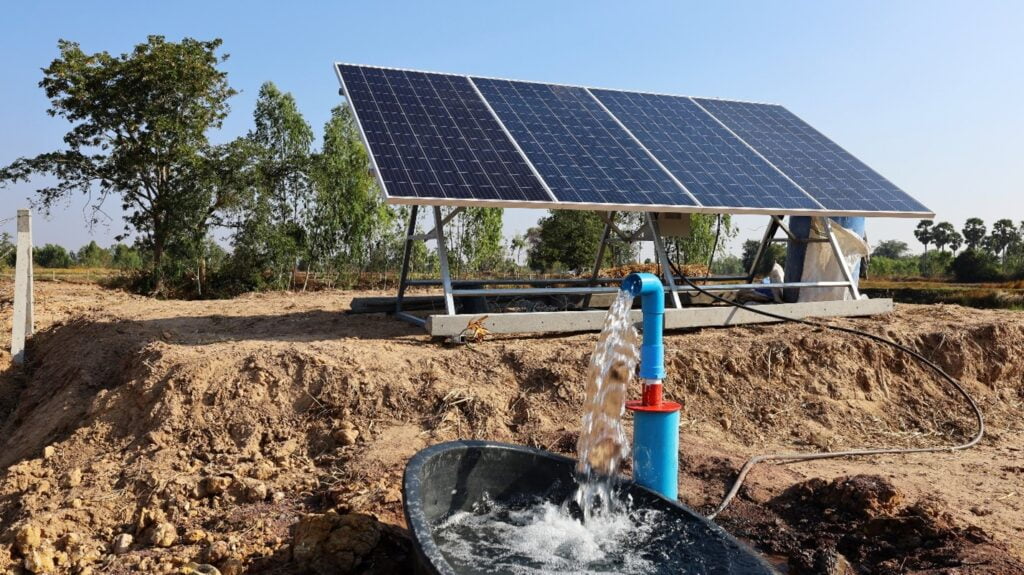With the climate crisis intensifying, water scarcity and water-related risks such as floods and droughts are becoming more frequent and severe in Tanzania. Solar water pumps offer a sustainable solution to these challenges.
Rising temperatures disrupt precipitation patterns and the entire water cycle, exacerbating the situation. Dwindling water supplies, exacerbated by climate change and population growth, pose significant threats to food security in Eastern Africa.
Northern Tanzania has been facing a persistent drought, forcing its inhabitants to share water with livestock. Even though the Arusha and Kilimanjaro regions have wet areas, some of the regions’ areas are severely impacted by a lack of water and pastures for livestock, leading to heavy losses. Over 92,000 livestock were lost in Simanjiro, Manyara, last year.
This has pushed community members and animals to compete for scarce water and food. In 2022 media outlets like The Guardian reported how wildlife from conservation areas would forage into community farms and eat crops. Drought has forced nomadic pastoralists in many parts of East Africa to sneak their cattle into protected wildlife areas in search of water and fresh pastures.
Maria Lucas, a 30-year-old resident of Makame village in the Manyara region of northern Tanzania, holds up a glass of yellowish water and issues a challenge.
“We have been sharing water from ponds with wild animals and livestock,” Maria Lucas, a resident of Makame village in the Manyara region, said. “Can you people from the cities drink this kind of water?” She explained, “Villagers maize farms were invaded by buffaloes and elephants searching for something to eat”- a quotation from last year’s The Guardian.
Northern Tanzania is also home to indigenous groups, hunters, gatherers, or pastoralists, namely the Maasai, Hadzabe, Akie, and Barabaig. These “marginalized” communities suffer the most from extreme weather patterns.
Indigenous people make up approximately 33 percent of those living in extreme poverty in rural areas and 18.7% of the world’s extremely poor people.In addition to the drought, agrochemicals and mine pollution of drinking water are a major concern for the indigenous groups in Northern Tanzania.
The need for better mechanisms to lessen our vulnerabilities to drought is one lesson we should take from the drought crisis the Horn of Africa is currently experiencing. Tanzania’s losses from the drought and floods last year should spur us to spend money on innovative and sustainable solutions. Water solar pumps are one of the essential innovations, especially in areas where agriculture is heavily dependent.
Why Water Solar Pumps?
Solar-powered water pumps are a sustainable and green solution. Solar panels are, first and foremost, eco-friendly because they can be recycled. Eighty percent of their bulk materials are recyclable, and recycling them is profitable. Furthermore, because solar PV systems are closed systems, they don’t require fuel and don’t emit any emissions when they produce electricity.
They are simple to use because they require less work and maintenance than other kinds of pumps – diesel and electric pumps. They are effective in agriculture because they shorten the time needed to irrigate crops.
According to a recent global solar pump market report, only 14% as much labor is required to run solar PV systems as diesel generators. They have been shown to boost agricultural productivity, yields, and produce that isn’t seasonal.
According to Mr. Davis of the Davis & Shirtliff Group, a prominent provider of water-related equipment in the East African region, as quoted in the Daily News, water solar pumps have proven to be environmentally, economically, and operationally sustainable, significantly lowering the cost of access to clean and safe water for both household and industrial use, including, most importantly, farming.
Low-income farmers, pastoralists, indigenous people, and regions dependent on agriculture have a solution in solar pumps, which also solves the global warming problem. These pumps, which harness the power of the sun, not only reduce greenhouse gas emissions but also reduce the financial burden on farmers by eliminating fuel costs.
Solar pumps also help rural areas become more resilient to climate change and independent regarding energy, ensuring a steady water supply for farming operations even in remote locations.
A recent report shows that the solar pump market size is estimated to be valued at US$ 1.55 billion in 2023 and is expected to surpass US$ 4.64 billion by 2033. With countries like China, India, and Australia driving the demand for agricultural solar pumps, the Asia-Pacific region dominates the world market for solar pumps.
Overcoming Barriers to Solar Water Pumps Adoption in Africa
I can think of three factors contributing to the low demand for solar pumps in Africa: high upfront costs, system immobility, and lack of or little information on solar pumps. A consumer research study on the use of solar pumps in East Africa showed that customers who bought solar water pumps were wealthier, more educated, and less risk-averse than customers who purchased other off-grid products.
However, several factors reducing the demand for solar pumps are being addressed as technology and solar solutions advance. A good example is the solar-powered battery produced by Bourgeois Global that can be connected to a solar pump. The battery is very light and easily transportable, making it ideal for communal groups like indigenous people, migrants, and refugees.
To conclude, Solar pumps are one of many ways to mitigate the effects of extreme weather patterns. By drawing lessons from the drought in Eastern Africa, we can develop strategies and infrastructure that promote water conservation, efficient and effective irrigation systems, and sustainable agriculture practices.
By working with international organizations and exchanging knowledge with other regions facing comparable difficulties, we can improve our capacity to adapt to and respond effectively to future droughts.

